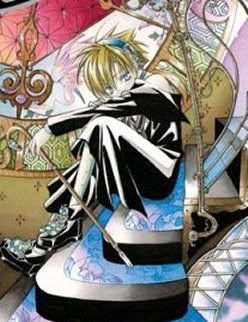
Author: Kazue Kato
Genre: action, supernatural
Target Age: Teen
Content: violence, language, supernatural elements, some scary scenes, some suggestive humor
Episodes/Volumes: ongoing
Story: Twin brothers Rin and Yukio Okumura were raised since birth by the priest and exorcist Shiro Fujimoto. Since he was seven, Yukio secretly trained to be an exorcist. When they are teenagers, their guardian Fujimoto is possessed by Satan, ruler of Gehenna, and dies. It turns out that Rin and Yukio are the sons of Satan by a human woman. Because Yukio developed with a weak body, all of Satan's power was inherited by Rin. Satan intends to use Rin's power to invade Assiah, the human world. Rin decides to use his power to defeat Satan once and for all, so he goes to True Cross Academy, the Japanese branch of a worldwide organization led by the Vatican. He is shocked to discover that not only is his brother Yukio already an exorcist, but also one of his instructors.
Along the way, Rin meets other students training to be exorcists. His superiors, Yukio included, order him to keep his powers a secret, so when a demon shows up and needs to be destroyed, he often runs off to take it on alone. Unfortunately, this leads to his classmates assuming that he's trying to hog the glory for himself. Inevitably, bonds form between the classmates, but this bond is put to the test when they learn Rin and Yukio's parentage. When the leaders of the Vatican find out about Rin's powers, Rin's circumstances go from bad to worse. It does not help that the headmaster of True Cross Academy, Mephisto Pheles, has plans of his own for Rin. (It also doesn't help that Mephisto is Rin and Yukio's half-brother. Guess which parent.)
Though Yukio is the younger of the two, he tries to protect Rin and help his brother maintain his humanity. Yukio is terrified that if he doesn't keep an eye on Rin, Rin's powers may overtake him and transform him into a complete demon. Though it's not touched upon a lot, Yukio is also afraid for himself because something strange is happening to his own body. Thankfully, he doesn't have to handle Rin alone; a high ranked exorcist named Shura helps train Rin to control his powers. He hates her guts, but at least he performs her training exercises.
Character interactions can be intense, and each character has his or her own quirks. A rivalry develops between Rin and his classmate Bon. The rivalry stems from Bon's insistence that Rin learn to rely on others to complete a mission rather than try to be the hero. Izumo puts on a tough girl show and is initially cold to everyone. She is especially so towards the seemingly naive Shiemi, but Shiemi's optimism (and tendency to see the world through rose colored glasses) gradually enables Izumo to loosen up. In an anime only storyline, the young monk Konekomaru allows himself to be possessed by a demon out of a desire to kill Rin because Satan killed everyone at his temple. This is dealt with in a single episode, but it illustrates an interesting conundrum. Many characters in the series are after Rin for one agenda or another, but the reason is because of his bloodline, or at least his powers. Those who attack him out of hatred for his bloodline are curiously oblivious towards Yukio. It seems they are okay with Yukio being the son of Satan simply because he did not inherit Satan's power.
Availability: The manga is already available in North America. The anime does not have an English dub yet, but will be released in North America starting in December 2011. It can currently be viewed online on Hulu and Crunchyroll.
Music: First Season One opening: "Core Pride" by Uverworld
Second Season One opening: "In My World" by ROOKiEZ is PUNK'D
First Season One ending: "Take Off" by 2PM
Second Season One ending: "Wired Life" by Meisa Kuroki
Recommendation: Anyone who likes supernatural based stories and action may enjoy this. A word of caution for the easily offended: the story basically uses Christianity from the Japanese point of view, and the interactions between humans and demons are not always of the hostile variety. The revelation of Satan's true motives for wanting to take over Assiah may be a little weird for some people.



